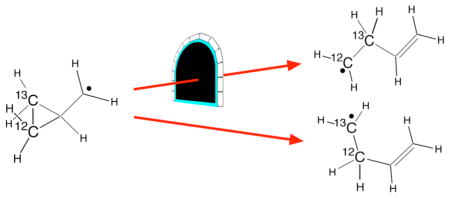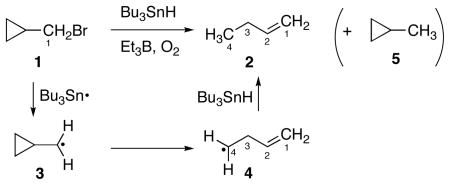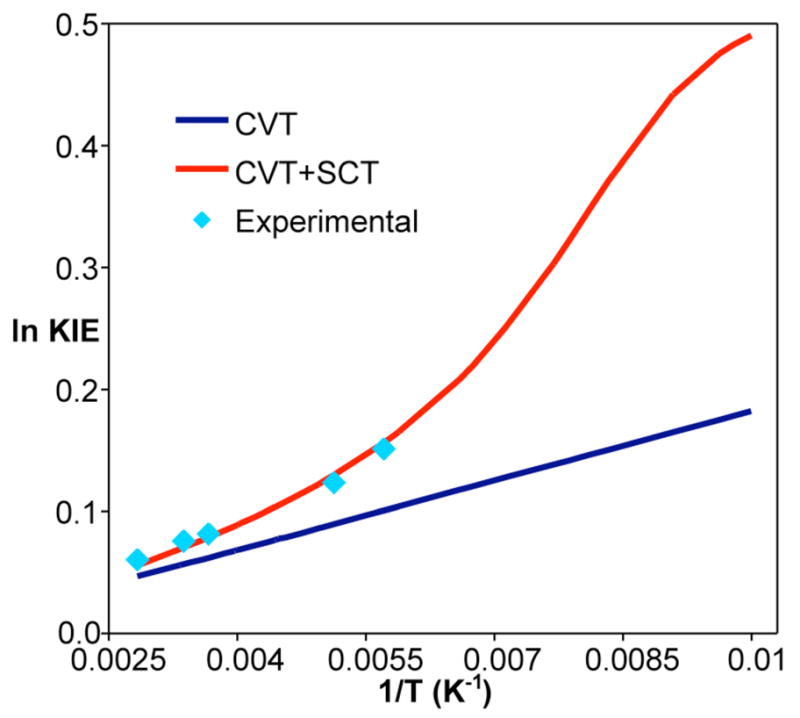Abstract

The intramolecular 13C kinetic isotope effects for the ring-opening of cyclopropylcarbinyl radical were determined over a broad temperature range. The observed isotope effects are unprecedentedly large, ranging from 1.062 at 80 °C to 1.163 at −100 °C. Semi-classical calculations employing canonical variational transition state theory drastically underpredict the observed isotope effects, but the predicted isotope effects including tunneling by a small-curvature tunneling model match well with experiment. These results and a curvature in the Arrhenius plot of the isotope effects support the recently predicted importance of heavy-atom tunneling in cyclopropylcarbinyl ring-opening.
Tunneling is a fundamental physical phenomenon that affects the rates of barrier crossings in all chemical reactions. In most reactions, the effects of tunneling are subtle and the impact of tunneling on experimental observations is not readily recognizable. This is particularly true of reactions involving heavy-atom tunneling, since the probability of tunneling decreases rapidly with increasing mass. The theoretical support for heavy-atom tunneling is unquestioned, but its experimental manifestations are less obvious.
The most common evidence for heavy-atom tunneling has been the observation of reactions that occur at cryogenic temperatures, where there is little thermal energy to allow passage over a reaction barrier.1,2,3,4 Without tunneling, calculations show that passage over the barrier is much too slow to account for the measured reaction rates, but the inclusion of tunneling provides calculated rate constants that are in good agreement with those that have been measured.
Accurate theoretical calculations can be used to predict the contribution of tunneling to a reaction at any temperature. However, for reactions that are carried out at non-cryogenic temperatures, the question of what experimental observations, by themselves, reliably implicate heavy-atom tunneling remains open.
We describe here an experimental study of the intramolecular 13C kinetic isotope effect (KIE) for the ring-opening of the cyclopropylcarbinyl radical (3).5 The results reveal an unprecedentedly large 13C KIE and confirm recent predictions of an important role for tunneling in this reaction. A careful scrutiny of the temperature dependence of the KIE reveals an experimental diagnostic of heavy-atom tunneling in the ring opening of 3 that does not depend on a comparison between predicted and measured rate constants.
Datta, Hrovat, and Borden have recently predicted that tunneling should make the ring-opening of 3 fast at 20 K.6 A narrow reaction barrier is calculated to allow tunneling to occur rapidly, without any thermal activation, from the molecule’s vibrational ground state. We sought to determine if tunneling in the ring opening of 3 would be apparent in experimental observations made at higher and more routinely accessible temperatures in solution.
Toward that end, we studied the intramolecular 13C KIE7 for the ring opening of 3. As probes for tunneling, intramolecular KIEs have significant advantages over absolute rate measurements; intramolecular KIEs reflect only the first irreversibly desymmetrizing step in a mechanism and they can be readily determined precisely at a broad range of temperatures. To measure the intramolecular KIEs in the ring opening of 3, samples of bromomethylcyclopropane (1) at natural abundance were reduced at temperatures ranging from −100 °C to 80 °C under free-radical chain conditions, employing tributyltin hydride as the reductant and triethylborane / O2 as the initiator. This reduction affords 1-butene (2) as the major product, arising from the ring-opening of 3, along with small amounts of methylcyclopropane (5), formed by the reduction of 3 before ring-opening. Under the conditions employed, the ring-opening of 3 should be irreversible (see the Supporting Information for a discussion).
The relative 13C content in the C-3 versus C-4 positions of 2 was analyzed by NMR.7 In all cases, less 13C was observed at the C-4 position of the 1-butene than at C-3, reflecting a preference for 12C to undergo the bond-breaking process that places it in C-4 of the ring-opened radical 4. The intramolecular KIEs that are defined by the ratios of 13C at C-3 and C-4 are summarized in Table 1.
Table 1.
Experimental and Predicted Intramolecular 13C KIEs for the Ring-Opening of Cyclopropylcarbinyl Radical.
| temperature (° C) | experimental KIEa,b,c | predicted KIEd | |
|---|---|---|---|
| without tunneling | with tunneling | ||
| 80 | 1.062 ± 0.003 | 1.048 | 1.057 |
| 22 | 1.079 ± 0.002 | 1.058 | 1.073 |
| 0 | 1.085 ± 0.003 | 1.064 | 1.082 |
| −78 | 1.131 ± 0.002 | 1.093 | 1.138 |
| −100 | 1.163 ± 0.004 | 1.106 | 1.169 |
Defined as k12C/k13C(for C-4)/k12C/k13C(for C-3).
Uncertainties are 95% confidence ranges, based on 12 measurements at 80, 22, and 0 °C, 18 measurements at −78 °C, and 6 measurements at −100 °C.
The reactions at 80, 22, and 0 °C were conducted in o-dichlorobenzene and those at −78 and −100 °C in methylcyclohexane.
KIE predictions without and with tunneling are based on CVT and CVT / SCT rate constants, respectively, calculated on the UB3LYP/6-31G* potential energy surface.

The KIEs in Table 1 are strikingly large. Even at 80 °C, the 13C isotope effect is over 6%, and the 13C KIE ultimately increases to 16% at −100 °C. Larger 13C magnetic isotope effects have been observed,8 but among conventional 13C KIEs, those in Table 1 are the largest known at each temperature.
In order to investigate the role that tunneling plays in the 13C KIEs in Table 1, the KIEs were computed both with and without inclusion of tunneling. Canonical variational transition state theory (CVT)9 was used to calculate the semi-classical rate constants, without tunneling, and the effect of multidimensional tunneling on the reaction dynamics was computed using the small-curvature tunneling (SCT) approximation.10 These calculations were carried out on the UB3LYP/6-31G* potential energy surface using GAUSSRATE.11 as the interface between POLYRATE12 and Gaussian03.13
As shown in Table 1, the theoretical KIEs without allowance for tunneling drastically underpredict the size of the observed values. The error in these predictions grows larger as the temperature decreases, rising to as large as 6%, but the error is still substantial at the high end of the temperature range. In contrast, the predicted KIEs that include tunneling match well with experiment throughout the broad temperature range, with the error never exceeding 0.7%.
The effect of tunneling on the absolute rate of the ring opening of unlabelled 3, calculated from the ratio of CVT versus CVT / SCT rate constants, is a factor of 1.3, 1.5, 1.6, 2.9, and 4.1 at 80, 22, 0, −78, and −100 °C, respectively. With these modest calculated rate accelerations, in this temperature range the experimental rate constants14 do not unequivocally implicate heavy-atom tunneling, even when compared to the results of high-quality rate calculations.6 An Arrhenius plot of the calculated rate constants from 128 to 395 K shows some modest curvature,6 but experimental studies over this broad range have not been sufficiently precise to establish the curvature that would signify heavy-atom tunneling.14,15
Is it possible, then, to use the measured KIEs, in order to infer that tunneling is important in the ring opening of 3, without recourse to comparing the measured KIEs to calculated? The increase in the KIE due to tunneling grows from approximately 1% at 80 °C to 6% at −100 °C, the latter being over a third of the total isotope effect. As a result, the experimental KIE grows much faster than semi-classical expectations as the temperature is decreased. This fact is recognizable in the curvature in the Arrhenius plot of ln KIE versus 1/T, shown in Figure 1.
Figure 1.

Arrhenius plot of the CVT, CVT + SCT, and experimental 13C KIEs for the ring-opening of 3 from 100 to 353 K.
A least squares fit to the three high-temperature points gives Ea(13C) − Ea(12C) = 52 cal/mol and A(12C)/A(13C) = 0.987. For comparison, the two low-temperature points give Ea(13C) − Ea(12C) = 85 cal/mol and A(12C)/A(13C) = 0.908. Thermally activated tunneling by the lighter isotope increases the difference in the Ea values between 13C and 12C; and the effect of tunneling on lowering A values makes A(12C)/A(13C) ≪ 1.0, as the importance of tunneling for the lighter isotope increases.16
The extraordinarily large 13C KIEs and curvature in the Arrhenius plot of them are observable but subtle experimental indicators of heavy-atom tunneling. However, tunneling has a larger, if less directly measurable effect on the outcome of the reaction. For example, under our conditions at −100 °C this reaction produces 62% of 2 plus 38% of non-ring-opened 5. Without the rate acceleration provided by heavy-atom tunneling, 2 would only be 28% of the product. This example shows that a full understanding of ordinary observations can require allowance for the role of heavy-atom tunneling.
Supplementary Material
Acknowledgments
This research was supported by NIH grant # GM-45617 at Texas A&M and by NSF grant CHE-0910527 at UNT. WTB also thanks the Robert A. Welch Foundation for financial support.
Footnotes
Supporting Information Available: Complete descriptions and data for experiments and calculations and complete lists of authors for references 12 and 13. This material is available free of charge via the Internet at http://pubs.acs.org.
References
- 1.Sheridan RS. In: Reviews in Reactive Intermediate Chemistry. Moss RA, Platz MS, Jones MJ Jr, editors. John Wiley & Sons; New York: 2007. pp. 416–458. [Google Scholar]
- 2.(a) Carpenter BK. J Am Chem Soc. 1983;105:1700–1701. [Google Scholar]; (b) Huang MJ, Wolfsberg M. J Am Chem Soc. 1984;106:4039–4040. [Google Scholar]; (c) Dewar MJS, Merz KM, Jr, Stewart JJP. J Am Chem Soc. 1984;106:4040–4041. [Google Scholar]; (d) Lefebvre R, Moiseyev N. J Am Chem Soc. 1990;112:5052–5054. [Google Scholar]; (e) Redington RL. J Chem Phys. 1998;109:10781–10794. [Google Scholar]
- 3.Zuev PS, Sheridan RS, Albu TV, Truhlar DG, Hrovat DA, Borden WT. Science. 2003;299:867–870. doi: 10.1126/science.1079294. [DOI] [PubMed] [Google Scholar]
- 4.Moss RA, Sauers RR, Sheridan RS, Zuev PS. J Am Chem Soc. 2004;126:10196–10197. doi: 10.1021/ja0488939. [DOI] [PubMed] [Google Scholar]
- 5.For previous uses of carbon KIEs to implicate tunneling, see Miller DJ, Subramarian R, Saunders WH., Jr J Am Chem Soc. 1981;103:3519–3522.Wilson JC, Kallsson I, Saunders WH., Jr J Am Chem Soc. 1980;102:4780–4784.Meyer MP, DelMonte AJ, Singleton DA. J Am Chem Soc. 1999;121:10865–10874.
- 6.Datta A, Hrovat DA, Borden WT. J Am Chem Soc. 2008;130:6684–6685. doi: 10.1021/ja801089p.The barrier height is about 7 kcal/mol and a C-C distance must only increase from 1.53 Å in 3 to 2.51 Å in 4.
- 7.(a) Singleton DA, Szymanski MJ. J Am Chem Soc. 1999;121:9455–9456. [Google Scholar]; (b) Singleton DA, Schulmeier BE. J Am Chem Soc. 1999;121:9313–9317. [Google Scholar]; (c) Kelly KK, Hirschi JS, Singleton DA. J Am Chem Soc. 2009;131:8382–8383. doi: 10.1021/ja9031083. [DOI] [PMC free article] [PubMed] [Google Scholar]; (d) Ussing BR, Hang C, Singleton DA. J Am Chem Soc. 2006;128:7594–7607. doi: 10.1021/ja0606024. [DOI] [PMC free article] [PubMed] [Google Scholar]
- 8.(a) Buchachenko AL. Chem Rev. 1995;95:2507–2528. [Google Scholar]; (b) Turro BJ, Kraeutler B. Acc Chem Res. 1980;13:369–377. [Google Scholar]
- 9.Truhlar DG, Garrett BC. Annu Rev Phys Chem. 1984;35:159. [Google Scholar]
- 10.Fernandez-Ramos A, Ellingson BA, Garrett BC, Truhlar DG. In: Reviews in Computational Chemistry. Lipkowitz KB, Cundari TR, editors. Vol. 23. Wiley-VCH; Hoboken, NJ: 2007. pp. 125–232. [Google Scholar]
- 11.Corchado JC, Chuang Y-Y, Coitino EL, Ellingson BA, Zheng J, Truhlar DG. GAUSSRATE, version 9.7. University of Minnesota; Minneapolis, MN: 2007. [Google Scholar]
- 12.Corchado JC, et al. POLYRATE–version 9.7. University of Minnesota; Minneapolis, MN: 2007. [Google Scholar]
- 13.Frisch MJ, et al. Gaussian 03, revision D.02. Gaussian, Inc; Wallingford, CT: 2004. [Google Scholar]
- 14.Newcomb M, Glenn AG. J Am Chem Soc. 1989;111:275. [Google Scholar]
- 15.Maillard B, Forrest D, Ingold KU. J Am Chem Soc. 1976;98:7024–7026. [Google Scholar]
- 16.At temperatures low enough that both the light and heavy isotopes cross the reaction barrier by tunneling, the difference between their Ea values decreases until it becomes zero when tunneling occurs only from the lowest vibrational levels. As the difference in Ea values approaches zero, the greater tunneling by the lighter isotope makes A(12C)/A(13C) > 1.0.
Associated Data
This section collects any data citations, data availability statements, or supplementary materials included in this article.


